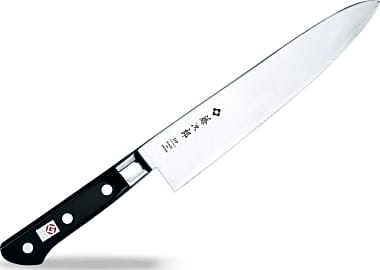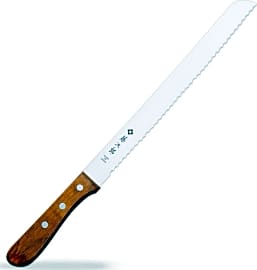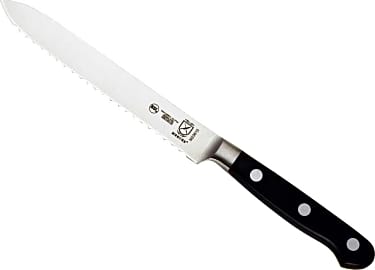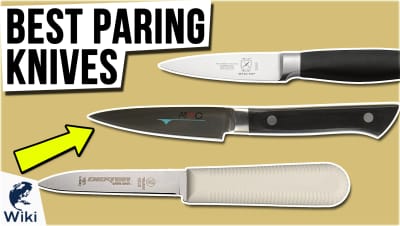The 7 Best Tomato Knives

This wiki has been updated 36 times since it was first published in October of 2016. Since they’re firm on the outside and soft on the inside, tomatoes can be notoriously tricky to slice, even for many experienced cooks. Fortunately, the knives featured in our selection are specially designed with serrated edges to produce clean cuts with little effort. Many are also good for use with other thick-skinned fruits, as well as vegetables, cheeses, breads, and meats. When users buy our independently chosen editorial selections, we may earn commissions to help fund the Wiki.
Editor's Notes
April 23, 2021:
We decided to scrap our previous rankings in favor of a slimmed-down and highly pragmatic set of suggestions. This is because, with years of combined culinary experience, we've found that unitaskers, or knives that are meant for exactly one purpose, tend to be expensive and not particularly useful. To that end, none of our new top three selections are actually manufactured specifically for cutting tomatoes, but we're fully confident that they're actually the best choices for the job.
For example, consider the Mercer Millennia bread knife in our top spot. The truth is, if you only ever use it to cut tomatoes, you'll be able to slice many, many pounds before it needs sharpening. You'll also see the Tojiro DP, a gyuto or all-purpose Japanese chef's knife, in our top 3. As long as you keep it sharp - which is something everyone should learn to do - its ultra-slim blade and high-end, stain-resistant alloy make it perfect for tomatoes. There's also the Tojiro F-737, another bread knife, which is considerably thinner and easier to maneuver than similar models.
There are, of course, knives meant just for tomatoes. They're also good for other small fruits. If that's the route you want to take, we recommend the Cuisinart C77TR, because it works and is highly affordable. There's also the Wusthof Classic 4128, which isn't specifically for tomatoes, but as the manufacturers insist that it's a "deli knife," it makes sense that its reverse-scalloped blade works perfectly on the soft red produce.
March 12, 2020:
Today we added in the Hammer Stahl HS-6315, which is just about as fun to look at as it is to use. Its durable, resin-infused pakkawood handle gives it an elegant wooden appearance, combined with the durability of plastic. As for the blade, it features three cut-out areas to help keep food from sticking, and its handy spear tip is great for placing your cut-up vegetables, fruits, cheeses, and meats onto a serving platter or charcuterie board. The blade features fine serrations that help it to slice through your foods with ease.
Another new addition is the Victorinox 4.25-Inch, a highly cost-effective set of six identical serrated utility knives that are practical for any busy household kitchen. Like other models from Victorinox, these are praised again and again for their sharpness, and how well they retain it. Their plastic handles make them easy to care for, and they’re conveniently dishwasher safe. (Although be aware that many experts recommend not putting your knives in the dishwasher, anyway, as their edges can become damaged in the wash cycle.) The bottom line is they come at a great price per knife, and you’ll likely get lots of regular use out of them. This model replaces the Victorinox Cutlery Fork-Tipped, which is unavailable at this time.
The 32 Dumas 4.75-Inch also joins our list today, and this one is made in Thiers, France, which is also known as the capital of French cutlery. The company bills itself as the oldest brand of French cutlery still around, in fact. It makes its knives with a single steel bar (also known as fully forged construction), for durability. It uses nitrogen strengthened French stainless steel, which is designed to improve hardness, cutting ability, and edge retention.
Others that leave the list today, due to issues with availability, are the Ginsu Essentials and the Brandobay Stainless Steel. For more reliable choices for slicing fruits and vegetables, check out our list of best paring knives.
Always practice knife safety by taking some simple precautions: Cut objects like tomatoes and onions in half first so you have a stable, flat-bottomed surface to work with. Bend your fingers when you’re gripping the food to help keep them safely away from the working blade. Be sure to use a knife that’s sharp, which is much easier to use than a dull one, and requires less pressure on your part.
A Fruit By Any Other Name
At the heart of the best bruschetta is a perfectly ripe, diced red fruit.
It is said that knowledge is knowing that a tomato is a fruit, wisdom is keeping it out of the fruit salad, and philosophy asks if ketchup is, then, a smoothie. What's not debatable is that a little salt and pepper sprinkled on a juicy, heirloom tomato slice is delicious. In fact, this tasty plant is an integral part of such monumental culinary creations as the famed Caprese sandwich and the classic marinara sauce. At the heart of the best bruschetta is a perfectly ripe, diced red fruit. Tomato concassé is a widely used method of peeling tomatoes using boiling water and an ice bath; after removing the peels and seeds, the remaining flesh is ready for inclusion in haute cuisine.
It's true that we wouldn't have pizza or bolognese without this marvelous food. And those little, tiny ones, of the grape or cherry variety? The sweetness of those miniature strains is hard evidence that they are, in fact, fruit. For that matter, are you in the turkey club? Because no sandwich is the same without toothpicks, a triangle cut, and the moisture provided by a big slice of solano lycopersicum.
So, it's established that tomatoes are central to a lot of our favorite foods. Interestingly, more people are focusing on unique varieties of this food than on most vegetables and fruits. This is because of the difficulty of providing properly ripe product to stores and food manufacturers. Over the last century, plant breeders have used genetic hybridization to create varieties that actually ripen during the shipping process and retain their firmness longer, thus lasting longer in the store. Unfortunately, while the plant has been selected for shelf life, that advancement has been at the cost of flavor and nutrition. So, we're left with firm and flavorless produce from some grocery stores.
While high-tech fixes are on the way, the current solution to this is the heirloom tomato, which is one of many types of the plant that's more difficult to grow and ship properly. This makes it less prolific and more expensive, but the added flavor is often worth the cost. It also means it'll be softer than the pale, mass-produced examples. Once you get that ultra-ripe beauty home, that's when the real fun begins.
When Softer Is Harder To Slice
In the days of Shakespeare, attendees would bring rotten vegetables to showings at the Globe theater just in case the actors delivered less-than-stellar performances. The standard food of choice for chucking at the stage was the tomato — but it definitely had to be rotten. While a moldy fruit in the face is a shame, an unripe one to the head could mean a bad actor's final performance. Even though a nicely ripe tomato certainly splatters well, its softness can actually make it very difficult to slice open. Hack away at a juicy specimen, and you'll only succeed in smashing it, as the skin defies and turns your blade at each chop. Don't worry, you've made the right choice: that thick skin is indicative of both great flavor and nutrition. But how do you separate your salad topping into appropriately sized pieces? There's a knife for that.
A standard chef's knife will leave you sawing back and forth, dulling the blade and making consistent cuts difficult. Serrated knives have the sharp points needed to bite into the resilient skin even if the flesh is soft as can be, but bread knives, the most common serrated variety, are large and unwieldy when you're trying to julienne a roma. So there's a smaller type of serrated blade that's perfect for slicing tomatoes. It's just the right size and will keep you cutting food and not your fingers. And, naturally, the name of the game among many cooks and chefs is who can acquire the most toys.
Always Play It Safe
Like any different kind of knife, there's a wide range of features and styles available, so you can find exactly the right tool to suit your purpose. The tomato has a high water content, so it's important that the knife's handle is easily gripped and doesn't slip, even when wet. Additionally, many models have a split tip that's perfect for plucking the stems out of produce without having to put down the knife and pick up a different tool.
The tomato has a high water content, so it's important that the knife's handle is easily gripped and doesn't slip, even when wet.
The major drawback of most serrated knives is that they're difficult to sharpen. Straight knives require knowledge and technique to keep razor-sharp, but the process is pretty simple. Serrated blades, however, require painstaking attention using multiple grades of handheld files, each small enough to fit in the individual serrations in the metal of the blade. It's usually a better idea to have the manufacturer or another professional sharpener tackle your dull bread or tomato knife.
On the other hand, you won't have to sharpen these blades quite as often as you would a chef's knife. This is because those sharp notches help the knife rip through the strong skin even if they're not perfectly honed. Also, because you generally can't make hard, downward chops with a serrated blade, the edge won't curl over as easily as it would from, for example, mincing parsley with a french-style knife.
As with all kitchen knives, quality and features vary across a wide spectrum. Inexpensive models can work better in settings where they might take a little abuse, like larger kitchens and corporate catering institutions. For the home chef, a German-made knife with deeply scalloped serrations and a three-rivet handle can really make working with foods more pleasant. High-end options are made from more durable steel that holds edges longer, and their increased weight and substantial feel really make the job safer.
Above all, make sure to clean and dry your knives and all your tools as thoroughly as possible to keep them in peak condition, so you can cook with ease for a long time to come.












